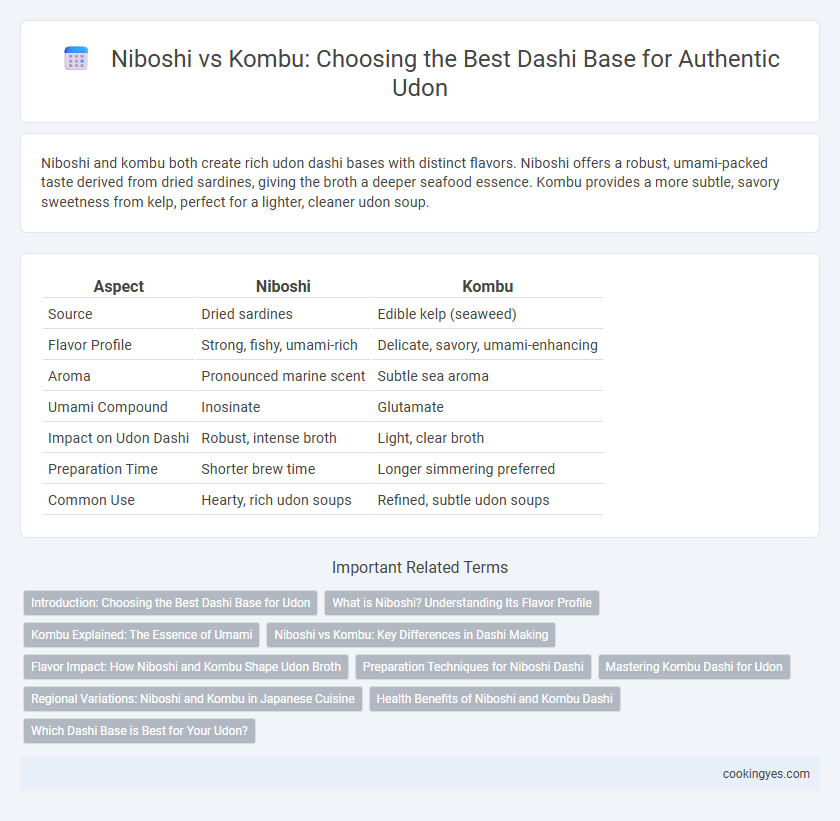Niboshi and kombu both create rich udon dashi bases with distinct flavors. Niboshi offers a robust, umami-packed taste derived from dried sardines, giving the broth a deeper seafood essence. Kombu provides a more subtle, savory sweetness from kelp, perfect for a lighter, cleaner udon soup.
Table of Comparison
| Aspect | Niboshi | Kombu |
|---|---|---|
| Source | Dried sardines | Edible kelp (seaweed) |
| Flavor Profile | Strong, fishy, umami-rich | Delicate, savory, umami-enhancing |
| Aroma | Pronounced marine scent | Subtle sea aroma |
| Umami Compound | Inosinate | Glutamate |
| Impact on Udon Dashi | Robust, intense broth | Light, clear broth |
| Preparation Time | Shorter brew time | Longer simmering preferred |
| Common Use | Hearty, rich udon soups | Refined, subtle udon soups |
Introduction: Choosing the Best Dashi Base for Udon
Niboshi and kombu both serve as essential dashi bases for udon, each imparting unique flavors that define the dish's character. Niboshi, dried baby sardines, delivers a robust, umami-rich taste with a slightly smoky undertone, enhancing the depth of the broth. Kombu, a type of kelp, provides a subtle, clean oceanic flavor with a natural sweetness, making it ideal for achieving a light yet flavorful udon dashi.
What is Niboshi? Understanding Its Flavor Profile
Niboshi are small dried sardines commonly used in Japanese cuisine to create a rich, umami-packed dashi base for udon broth. Their flavor profile is characterized by a deep, savory taste with subtle bitterness and a pronounced oceanic aroma, providing a robust foundation that enhances the overall complexity of the dashi. Unlike kombu, which offers a more delicate, mineral-rich umami from kelp, niboshi imparts a stronger fish-based flavor that intensifies the broth's depth and heartiness.
Kombu Explained: The Essence of Umami
Kombu, a type of edible kelp, is prized for its rich umami flavor, making it an essential ingredient in udon dashi bases. Its natural glutamates enhance the broth's depth without overpowering the delicate udon noodles. Unlike niboshi, which adds a stronger fishy taste, kombu offers a subtle, savory foundation that highlights the noodles' texture and complements other dashi ingredients.
Niboshi vs Kombu: Key Differences in Dashi Making
Niboshi and kombu differ significantly in flavor profiles and dashi preparation for udon broth. Niboshi, dried sardines, impart a rich, umami-packed and slightly fishy taste ideal for robust udon soup bases, while kombu, a type of kelp, offers a subtle, clean, and savory umami flavor that forms a gentle, oceanic backbone. Choosing niboshi dashi enhances depth and intensity, whereas kombu dashi provides a lighter, more delicate foundation suited for refined udon dishes.
Flavor Impact: How Niboshi and Kombu Shape Udon Broth
Niboshi lends a rich, umami-packed depth with a slightly smoky and savory profile that intensifies udon broth, creating a bold, full-bodied flavor. Kombu, rich in glutamic acid, contributes a clean, subtle sweetness and mineral complexity, enhancing broth with a delicate, smooth umami foundation. Combining niboshi and kombu balances robust savoriness with mellow richness, resulting in a nuanced and deeply satisfying udon dashi.
Preparation Techniques for Niboshi Dashi
Preparation techniques for niboshi dashi involve soaking dried infant sardines in cold water for several hours to reduce bitterness before gentle simmering at low heat for 10-15 minutes to extract umami flavors without overcooking. Careful removal of heads and innards minimizes harshness, enhancing the clear, savory broth essential for udon dashi. This contrasted with kombu dashi, which relies on brief soaking and low-temperature extraction to preserve the delicate glutamates unique to kelp.
Mastering Kombu Dashi for Udon
Mastering kombu dashi for udon involves extracting deep umami flavors from kelp-rich kombu to create a delicate, savory base that enhances the noodle's texture. Kombu provides a clean, slightly sweet broth infused with glutamates that complement the chewy udon, unlike niboshi which imparts a stronger, fishy taste. Proper soaking and gentle heating of kombu unlocks its full flavor potential, making it ideal for achieving a balanced, refined udon dashi.
Regional Variations: Niboshi and Kombu in Japanese Cuisine
In Japanese cuisine, udon dashi bases vary regionally, with niboshi favored in the Kansai region for its rich, robust flavor derived from dried baby sardines, while kombu, a type of kelp, is preferred in Hokkaido for its subtle umami and clean taste. Niboshi-based dashi imparts a stronger fishy aroma that complements heartier, thicker udon noodles typical of Western Japan. Kombu dashi offers a lighter broth that accentuates the delicate texture of Hokkaido's udon, reflecting regional ingredient availability and culinary preferences.
Health Benefits of Niboshi and Kombu Dashi
Niboshi dashi, made from dried sardines, is rich in calcium, omega-3 fatty acids, and amino acids that support cardiovascular health and boost immunity when used as a base for udon soup. Kombu dashi, derived from edible kelp, offers abundant iodine, dietary fiber, and antioxidants that promote thyroid function and aid digestion. Both dashi types provide essential nutrients, making them healthy choices to enhance the nutritional profile of udon dishes.
Which Dashi Base is Best for Your Udon?
Niboshi-based dashi offers a rich, umami-packed flavor with a slightly briny undertone, perfect for a robust and traditional udon broth. Kombu dashi provides a delicate, smooth, and subtly sweet taste that enhances the broth's depth without overpowering the noodles. Choosing between niboshi and kombu depends on whether you prefer a stronger, fish-forward umami or a mild, clean vegetable richness in your udon dashi.
Niboshi vs Kombu for udon dashi base Infographic

 cookingyes.com
cookingyes.com